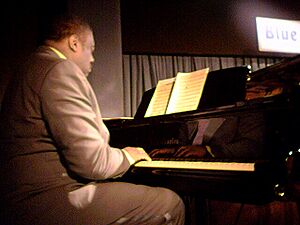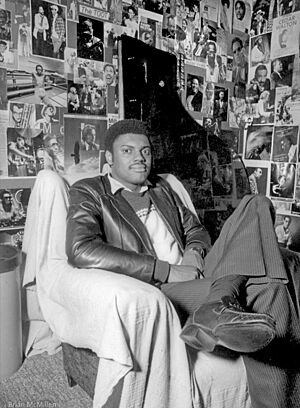Mulgrew Miller facts for kids
Quick facts for kids
Mulgrew Miller
|
|
|---|---|

Miller in 2004
|
|
| Background information | |
| Born | August 13, 1955 Greenwood, Mississippi, U.S. |
| Died | May 29, 2013 (aged 57) Allentown, Pennsylvania, U.S. |
| Genres | Jazz |
| Occupation(s) | Musician, composer, educator |
| Instruments | Piano |
| Years active | 1970s–2013 |
| Labels | Landmark, Novus, Maxjazz, Stunt |
| Associated acts | Art Blakey, Woody Shaw, Tony Williams |
Mulgrew Miller (born August 13, 1955 – died May 29, 2013) was an American jazz pianist, composer, and teacher. He started playing piano in churches as a child. He was inspired by pianists like Ramsey Lewis and Oscar Peterson.
Miller's unique style blended elements from these early influences. He also added the freer harmonies of McCoy Tyner. This helped him develop his own sound, which became very important in jazz from the 1980s onwards.
After college, he played with the Duke Ellington Orchestra. He then worked with singer Betty Carter. Later, he joined trumpeter Woody Shaw's band and Art Blakey's famous Jazz Messengers. During this time, Miller also started his own bands and recorded his own music. He was also a key member of drummer Tony Williams' quintet. He continued to play and record with many other jazz artists.
From 2005, Miller led the jazz studies program at William Paterson University. He kept performing and touring around the world. He played with other top jazz musicians until he passed away from a stroke at age 57.
Contents
Early Life and Musical Beginnings
Miller was born in Greenwood, Mississippi. His parents grew up on farms. He had three brothers and four sisters. Even though his family wasn't musical, they had a piano. Mulgrew started playing tunes on it by ear when he was six.
He began piano lessons at age eight. As a child, he played blues and rhythm and blues for dances. He also played gospel music in different churches. His main piano influence at this time was Ramsey Lewis.
While in high school, Miller formed a trio. They played at parties. His older brother told him to listen to pianist Oscar Peterson. Miller finally saw Peterson on TV when he was about 14. Watching Peterson play changed his life. He knew right then that he wanted to be a jazz pianist. Miller also looked up to Art Tatum and Erroll Garner as a teenager. He found playing fast easy, so he worked hard on playing slowly and with control.
After high school, Miller went to Memphis State University in 1973. He had a scholarship for music. He played the euphonium. During his two years there, he met pianists Donald Brown and James Williams. They introduced him to the music of jazz legends like Wynton Kelly, Bud Powell, and McCoy Tyner. Miller also met Woody Shaw at a jazz workshop. Shaw told him they would meet again, and they did two years later.
After leaving Memphis State in 1975, Miller took private lessons in Boston. He learned from Margaret Chaloff, who taught many pianists he admired. He also played with saxophonists Ricky Ford and Bill Pierce in Boston. Later, he moved to Los Angeles for a year. He played in local clubs and churches there.
A Career in Jazz: 1976–1994
In late 1976, Miller joined the Duke Ellington Orchestra. The band was then led by Mercer Ellington, Duke's son. Miller was supposed to play for only three weeks. But he ended up touring with them for almost three years. This experience helped him become known as a powerful and expressive pianist.
In 1980, Miller left the Ellington Orchestra. He joined singer Betty Carter's band and toured for eight months. From 1981 to 1983, he played with Woody Shaw's band. In 1981, he made his first studio recording on Shaw's album United. He also played with singer Carmen Lundy and saxophonist Johnny Griffin in the early 1980s. Miller got married on August 14, 1982.
Miller joined Art Blakey's Jazz Messengers in 1983. This was a very famous jazz group. At first, it was hard to fit in with Blakey's strong drumming. But Miller felt his playing matured a lot during his time with the band. He sometimes had solo piano spots in concerts. Being in the Jazz Messengers made his reputation in jazz even stronger.
Miller started recording his own music in 1985. His first album was Keys to the City. He recorded several albums for Landmark Records, including Work! in 1986. Critics noted that his playing showed influences from Bud Powell and Wynton Kelly. But he was also developing his own unique and strong style.
After leaving Blakey in 1986, Miller joined drummer Tony Williams' quintet. He played with them until about 1993. Miller also toured with his own groups. One of these was called Wingspan, formed in 1987. He named it after Charlie Parker, who was nicknamed "Bird." Wingspan became one of his main bands and featured many of his own songs. Another group was Trio Transition, which released an album in 1987.
Miller played on many other albums in the late 1980s. These included recordings with Steve Nelson, Donald Byrd, Frank Morgan, and Benny Golson. In 1989, Miller and his family moved to Palmer Township, Pennsylvania. That same year, he joined three other pianists to record a tribute to Phineas Newborn, Jr.. This group, the Contemporary Piano Ensemble, sometimes played on four separate pianos. In 1990, Miller went to the Soviet Union to play with Benny Golson's band at the first Moscow International Jazz Festival.
In 1992, Miller toured with the New York Jazz Giants. This was a septet (seven-piece band) with famous musicians like Jon Faddis and Tom Harrell. He also continued to play with singers like Dianne Reeves and Cassandra Wilson. From 1993, he played and recorded with saxophonist Joe Lovano. Miller's album Hand in Hand (1992) showed the influence of Tony Williams in its arrangements.
Later Career and Teaching: 1995–2013
After turning 40, Miller focused more on writing and playing his own music. He reduced how often he recorded and played in clubs. He had been on so many recordings that it became overwhelming. However, he still recorded with musicians he knew well. In 1996, he played on Tony Williams' last recording, Young at Heart. He also made albums with Kenny Garrett, Steve Nelson, and Dianne Reeves.
In 1997, Miller toured Japan with a group called 100 Golden Fingers. This group featured 10 pianists. In 1999, he recorded The Duets with bassist Niels-Henning Ørsted Pedersen. This album was inspired by performances from the 1940s by Duke Ellington and Jimmy Blanton. They toured Europe the next year.
In 2002, Miller started releasing more albums as a leader. Maxjazz released a series of live concert recordings. These included Live at The Kennedy Center Vol. 1 and Vol. 2 (from 2002), and Live at Yoshi's Vol. 1 and Vol. 2 (from 2003). In 2002, Miller joined bassist Ron Carter's Golden Striker Trio with guitarist Russell Malone. This trio toured internationally for about ten years. In 2003, Miller wrote music for the Dayton Contemporary Dance Company. He and his band performed the piece for the company's shows.
In the mid-2000s, Miller joined bassist Dave Holland's band. He helped add gospel and soul sounds to their music. Around this time, Miller also had two regular bands of his own: a piano trio and a quintet. He also became very involved in music education. From 2005, Miller was the Director of Jazz Studies at William Paterson University. He was also an Artist in Residence at Lafayette College in 2008.
Miller's only solo piano album, Solo, was released in 2010. It was a concert recording from 2000. Critics praised his imaginative playing. Also in 2010, Miller joined guitarist John Scofield's new band. That year, Miller had a minor stroke. After this, he took medicine, changed his diet, and lost weight. He also toured and recorded less. In 2012, he played with the Klüvers Big Band in Denmark. Selections from these concerts were released as Grew's Tune. In late 2012, he performed as a piano duo with Kenny Barron. He also toured Europe with a quintet led by Yusef Lateef and Archie Shepp.
On May 24, 2013, Miller had another stroke and was taken to the hospital. He passed away on May 29, 2013. Miller was survived by his wife, son, daughter, and grandson.
Miller made over 15 albums as a bandleader. He also appeared on more than 400 albums for other musicians. His last working trio included Ivan Taylor on bass and Rodney Green on drums. Bassist Christian McBride said that Mulgrew Miller left behind a lot of great music for everyone to enjoy.
Mulgrew Miller's Personality
Mulgrew Miller was known for being quiet and gentle. He was a modest person with a good sense of humor. In a 2005 interview, Miller talked about his approach to music. He said he worked hard to stay balanced emotionally. He believed in his faith and didn't focus only on being rich and famous. This gave him freedom to play music because he loved it, not just for money.
Mulgrew Miller's Style and Influence
Music critic Ben Ratliff said that Miller's compositions were hard to define. Like his piano playing, they were a mix of many styles. Critic Ted Panken noted that Miller's piano playing used interesting notes and rhythms. He blended church and blues sounds into his music. John Fordham described Miller's playing as having smooth melodies and strong chords. He said it reminded him of Oscar Peterson, but also showed the more modern harmonies of McCoy Tyner. Fordham also said Miller was much more than just a hard bop player. An obituary in DownBeat magazine said that Miller could play with great power. But he always kept grace and precision. His unique touch and skill influenced many musicians.
Many fellow musicians respected Miller. Pianist Geoffrey Keezer decided to become a pianist after seeing Miller perform in 1986. Vibraphonist Warren Wolf said Miller helped him early in his career. Miller connected him to jazz history. Robert Glasper also said Miller was an influence. He even wrote a tribute song called "One for 'Grew."
In 2010, Miller talked about how he played jazz standards. He believed in respecting the original melody. He tried to play it as truly as possible. He saw a solo as a creative way to improve the melody. Miller rarely copied recordings, which is common for jazz musicians. He felt this made his learning slower. But it also allowed him to express himself more freely. He developed his own understanding of the songs he played.
Miller felt that the kind of jazz he played was sometimes seen as old-fashioned. He contrasted his approach with musicians who made "interview music." This was music that was obviously different and got a lot of attention.
Discography


